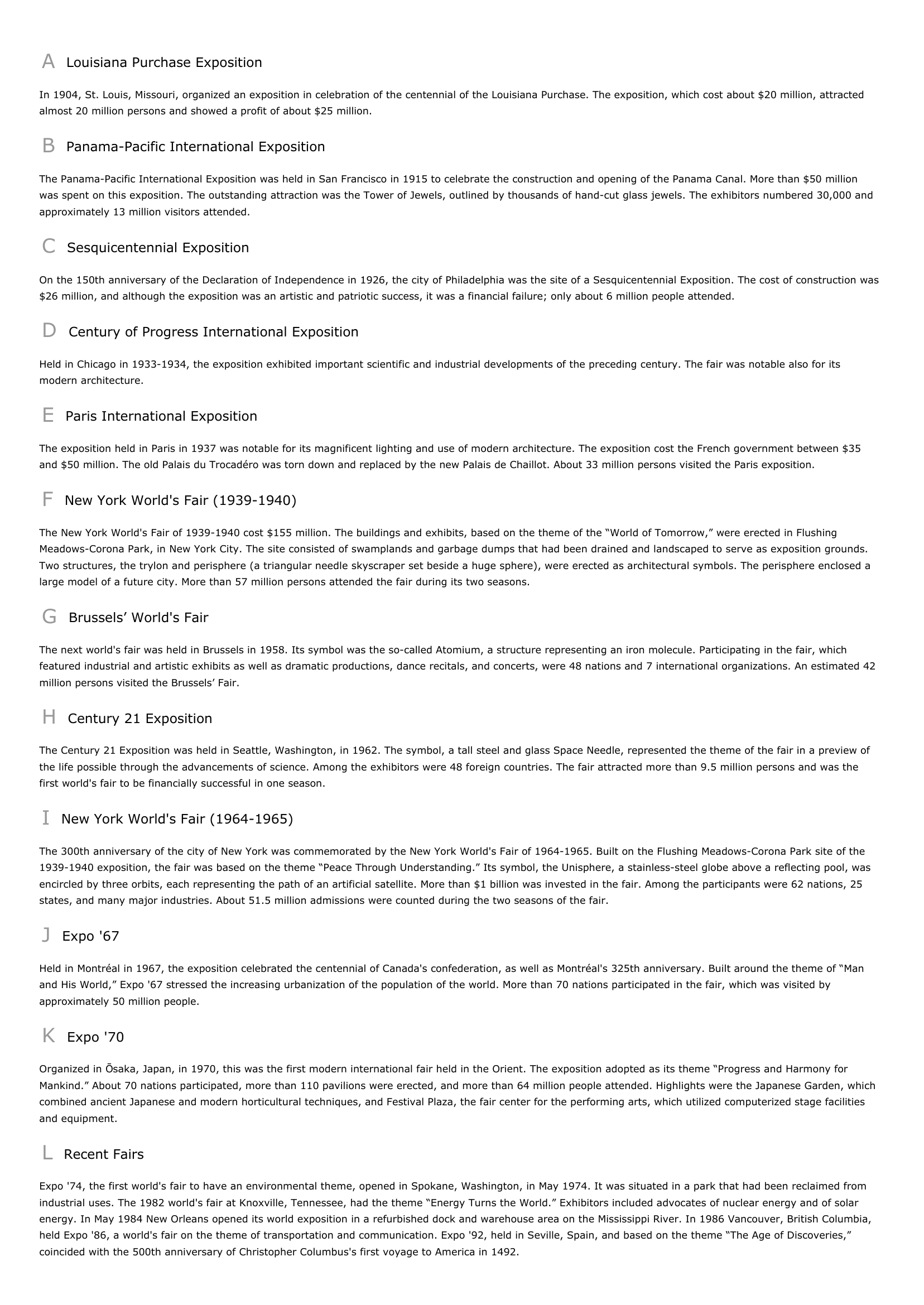Exhibitions and Expositions.
Publié le 10/05/2013
Extrait du document
«
A Louisiana Purchase Exposition
In 1904, St.
Louis, Missouri, organized an exposition in celebration of the centennial of the Louisiana Purchase.
The exposition, which cost about $20 million, attractedalmost 20 million persons and showed a profit of about $25 million.
B Panama-Pacific International Exposition
The Panama-Pacific International Exposition was held in San Francisco in 1915 to celebrate the construction and opening of the Panama Canal.
More than $50 millionwas spent on this exposition.
The outstanding attraction was the Tower of Jewels, outlined by thousands of hand-cut glass jewels.
The exhibitors numbered 30,000 andapproximately 13 million visitors attended.
C Sesquicentennial Exposition
On the 150th anniversary of the Declaration of Independence in 1926, the city of Philadelphia was the site of a Sesquicentennial Exposition.
The cost of construction was$26 million, and although the exposition was an artistic and patriotic success, it was a financial failure; only about 6 million people attended.
D Century of Progress International Exposition
Held in Chicago in 1933-1934, the exposition exhibited important scientific and industrial developments of the preceding century.
The fair was notable also for itsmodern architecture.
E Paris International Exposition
The exposition held in Paris in 1937 was notable for its magnificent lighting and use of modern architecture.
The exposition cost the French government between $35and $50 million.
The old Palais du Trocadéro was torn down and replaced by the new Palais de Chaillot.
About 33 million persons visited the Paris exposition.
F New York World's Fair (1939-1940)
The New York World's Fair of 1939-1940 cost $155 million.
The buildings and exhibits, based on the theme of the “World of Tomorrow,” were erected in FlushingMeadows-Corona Park, in New York City.
The site consisted of swamplands and garbage dumps that had been drained and landscaped to serve as exposition grounds.Two structures, the trylon and perisphere (a triangular needle skyscraper set beside a huge sphere), were erected as architectural symbols.
The perisphere enclosed alarge model of a future city.
More than 57 million persons attended the fair during its two seasons.
G Brussels’ World's Fair
The next world's fair was held in Brussels in 1958.
Its symbol was the so-called Atomium, a structure representing an iron molecule.
Participating in the fair, whichfeatured industrial and artistic exhibits as well as dramatic productions, dance recitals, and concerts, were 48 nations and 7 international organizations.
An estimated 42million persons visited the Brussels’ Fair.
H Century 21 Exposition
The Century 21 Exposition was held in Seattle, Washington, in 1962.
The symbol, a tall steel and glass Space Needle, represented the theme of the fair in a preview ofthe life possible through the advancements of science.
Among the exhibitors were 48 foreign countries.
The fair attracted more than 9.5 million persons and was thefirst world's fair to be financially successful in one season.
I New York World's Fair (1964-1965)
The 300th anniversary of the city of New York was commemorated by the New York World's Fair of 1964-1965.
Built on the Flushing Meadows-Corona Park site of the1939-1940 exposition, the fair was based on the theme “Peace Through Understanding.” Its symbol, the Unisphere, a stainless-steel globe above a reflecting pool, wasencircled by three orbits, each representing the path of an artificial satellite.
More than $1 billion was invested in the fair.
Among the participants were 62 nations, 25states, and many major industries.
About 51.5 million admissions were counted during the two seasons of the fair.
J Expo '67
Held in Montréal in 1967, the exposition celebrated the centennial of Canada's confederation, as well as Montréal's 325th anniversary.
Built around the theme of “Manand His World,” Expo '67 stressed the increasing urbanization of the population of the world.
More than 70 nations participated in the fair, which was visited byapproximately 50 million people.
K Expo '70
Organized in Ōsaka, Japan, in 1970, this was the first modern international fair held in the Orient.
The exposition adopted as its theme “Progress and Harmony forMankind.” About 70 nations participated, more than 110 pavilions were erected, and more than 64 million people attended.
Highlights were the Japanese Garden, whichcombined ancient Japanese and modern horticultural techniques, and Festival Plaza, the fair center for the performing arts, which utilized computerized stage facilitiesand equipment.
L Recent Fairs
Expo '74, the first world's fair to have an environmental theme, opened in Spokane, Washington, in May 1974.
It was situated in a park that had been reclaimed fromindustrial uses.
The 1982 world's fair at Knoxville, Tennessee, had the theme “Energy Turns the World.” Exhibitors included advocates of nuclear energy and of solarenergy.
In May 1984 New Orleans opened its world exposition in a refurbished dock and warehouse area on the Mississippi River.
In 1986 Vancouver, British Columbia,held Expo '86, a world's fair on the theme of transportation and communication.
Expo '92, held in Seville, Spain, and based on the theme “The Age of Discoveries,”coincided with the 500th anniversary of Christopher Columbus's first voyage to America in 1492..
»
↓↓↓ APERÇU DU DOCUMENT ↓↓↓
Liens utiles
- Ideology and Rationality in the History of the Life Sciences
- Relationship between religion, spirituality, and young Lebanese university students’ well-being.
- Course of reading and writing for 1st year English Licence
- dance and the different types of choreographie process
- Fiche de lecture sur le chapitre 11: The Greek of the New Testament, par Mark Janse, sur la section IV de l’ouvrage, intitulé: Ancient Greek: structure and change, pages 646-653.

































